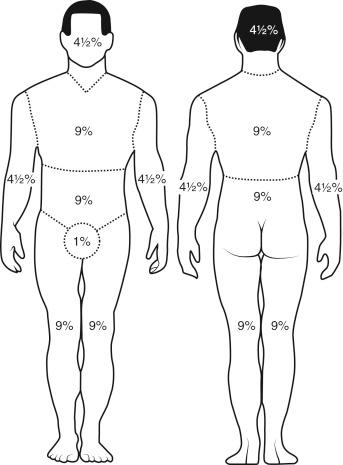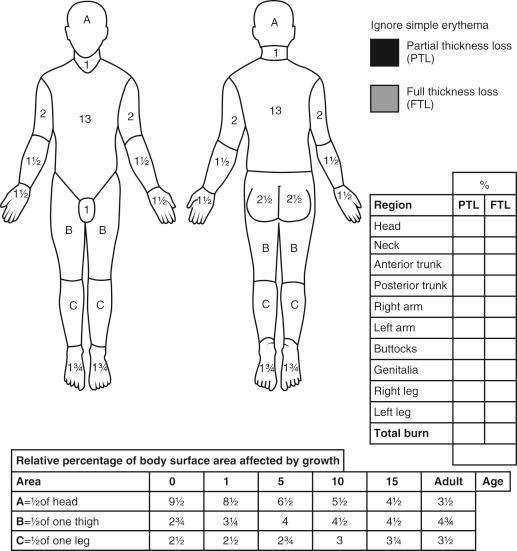Physical Address
304 North Cardinal St.
Dorchester Center, MA 02124
You are an anesthesiologist on call, and a surgical resident covering the burn unit books an emergency extremity fasciotomy. The patient, a 40-year-old homeless man, was rescued from a burning garage and admitted to the burn unit the night before. He was found unresponsive at the scene, with a toxic blood ethanol level and deep burns covering about 80% of his total body surface area (TBSA). He is on ventilatory support in volume-control mode, with a fraction of inspired oxygen (Fi o 2 ) of 0.8, positive end-expiratory pressure (PEEP) of 15 cm H 2 O, and a tidal volume of 400 mL. As you prepare to transport the patient to the operating room (OR), you notice that his peak airway pressure is high. You are concerned about decreased chest compliance and your ability to effectively ventilate and oxygenate the patient during transport and in the OR. You share your concerns with the attending surgeon, who decides to perform chest and abdominal escharotomies.
Burn injuries are caused by heat, electric current, or caustic or corrosive chemicals. The severity of injury is determined by the extent and depth of tissue destruction. Thermal burns result from contact of the skin or mucous membrane and the underlying tissues with the heat source for the extent of time sufficient to produce injury. The severity of the thermal burn is directly proportional to the temperature of the heat source and the duration and surface area of the contact, and is inversely proportional to the thickness of the skin and the blood supply to the contact area. Chemical burns result from a chemical reaction of an offending agent with tissue components, dehydration, or corrosion. Electrical burns occur by arcing of electrical current across two points of body surface resulting in external injuries, or by conduction of heat along vessels and nerves to produce deep injuries. A secondary thermal burn may result from ignition of clothing by arcing of electrical current.
The number of burn injuries occurring annually in the United States is estimated at between 1 million and 2 million. Each year, nearly 500,000 people seek treatment for burn injury, of whom 40,000 to 80,000 are hospitalized and 3500 to 5000 die. Most burned patients present in emergency departments of general hospitals without a dedicated burn center. Challenges in the initial care of patients with major burn injury include airway and ventilatory management, vascular access, fluid resuscitation, and pain management.
The severity of burn injury is determined by the percentage of total body surface area (TBSA) involved, depth of the burn, and the presence or absence of inhalational injury. TBSA burned is estimated using the “rule of nines” ( Fig. 78.1 ) or the Lund-Browder chart ( Fig. 78.2 ). The Lund-Browder chart is a diagram that accounts for age-specific changes in how the surface of various body parts contributes to TBSA, and thus it is better suited to estimate the size of burn injury in a child. The depth of a burn is defined as first, second, or third degree, based on whether there is superficial, partial-thickness, or full-thickness destruction of the skin.


First-degree burns (e.g., sunburn) are limited to the epidermis, appear as erythematous areas of otherwise intact skin, and may be painful, but heal without a specific intervention. Second-degree burns, or partial-thickness burns, partially involve the dermis, form blisters and moist, weeping lesions, blanch with pressure, and may be extremely painful. Second-degree burns require specific wound therapy including skin grafting. Third-degree or full-thickness burns involve the entire thickness of the dermis and may penetrate into the subcutaneous tissue.
The third-degree burn appears white, waxy, and is often speckled with red dots (i.e., heat-congealed hemoglobin). Sensory nerve endings are destroyed, so third-degree burns are insensate. Left untreated, third-degree burns heal by scarring that may result in severely disfiguring and crippling contractures; therefore third-degree burns should be excised and grafted early to preserve function. Inappropriate therapy, in particular, inadequate fluid resuscitation, may convert a second-degree burn injury to a full-thickness (third-degree) injury. Fourth degree is used to describe burns that involve deep structures, such as muscle, fascia, and bone.
Inhalation injury is present in 20% to 35% of hospitalized burn victims and is responsible for 60% to 70% of burn-related fatalities. It is important to recognize the inhalation injury as soon as possible. Inhalation injury should be suspected if the circumstances of the injury involve an exposure to fire and smoke in an enclosed space, especially in combination with loss of consciousness or intoxication. Findings on physical examination, including burns over the face, blisters on the lips and oral mucosa, singed nasal or facial hair, carbonaceous sputum, dysphagia, hoarseness, tachypnea, intercostal retraction, rales, and wheezing, point to the possibility of an inhalation injury. Early hypoxia may follow. Chest radiographs may be normal until the development of infection or atelectasis. Fiberoptic bronchoscopy may reveal carbonaceous debris, erythema, or ulcerations of the airway mucosa.
Major burns cause profound, generalized pathophysiologic changes. In the early postburn phase, tissue destruction at the site of the injury activates a cytokine-mediated systemic inflammatory response, characterized by increased capillary permeability and edema. When burn injury exceeds about 25% of TBSA, generalized edema develops. Loss of intravascular fluid due to generalized capillary leakage and weeping of fluids out of burned surfaces denuded of skin may quickly result in shock, with impaired tissue and organ perfusion. Burn shock occurs not only because of depletion of intravascular volume, but also because of increased systemic and pulmonary vascular resistance (due to release of catecholamines and vasopressin) and direct myocardial depression. Biochemical markers of the burn shock phase include hemoconcentration, lactic acidosis, and mixed venous desaturation. Shock leads to a decrease in glomerular filtration rate and stimulation of the renin–aldosterone–antidiuretic hormone axis, manifesting as acute oliguria. Hypothermia develops as a result of loss of thermoregulatory function of the dermis.
Within 48 to 72 hours after burn injury, the increased capillary leakage resolves, and edema formation significantly decreases. Fluid loss continues through open burn wounds. The shock phase is followed by the hypermetabolic phase, which starts a period of increased oxygen consumption, carbon dioxide production, increased protein catabolism, and insulin resistance. The hemodynamic picture during this phase is characterized by supranormal cardiac output, tachycardia, and low systemic vascular resistance. Patients with major burn injuries demonstrate increased requirements for most drugs, including sedatives, opioids, neuromuscular blocking agents, and antibiotics, owing to higher volume of distribution and increased clearance. The onset of sepsis, which may be extremely rapid and severe, aggravates the hyperdynamic state. Acute respiratory distress syndrome (ARDS) may develop.
Delayed consequences of burn injury include a persistent inflammatory state, immunosuppression, and severe protein catabolism, which continues until the closure of the burn wound. Burn wound infection is a leading cause of death in patients with burns exceeding 60% of TBSA. Early and repeated debridement of infected burn wounds is mandatory to maximize the patient’s chances of surviving the injury.
A full-thickness burn forms a rigid eschar over the burned area. Circumferential eschars of extremities may lead to compartment syndrome when edema forms under an eschar during an early phase of injury. Aggressive fluid resuscitation, essential in the management of the burn shock, may precipitate the development of the compartment syndrome. Unrecognized compartment syndrome may result in extensive muscle necrosis, rhabdomyolysis, secondary acute kidney injury, and the loss of affected extremities. Close monitoring of at-risk extremities and timely escharotomies are necessary to prevent secondary ischemic injury. Circumferential eschars of the trunk may result in a dramatic decrease in chest compliance and interfere with ventilatory mechanics. Such eschars also may require early escharotomies to enable effective ventilatory support.
Electrical injury often results in extensive, deep soft tissue damage that significantly increases resuscitative fluid requirements. Bone has the highest resistance to flow of electrical current, so the high heat produced by electrical current reaching the bone causes extensive damage of deep muscle surrounding the bone. Deep muscle injury may result in edema, compartment syndrome, muscle necrosis, and rhabdomyolysis. Myoglobinuria resulting from extensive muscle necrosis may lead to acute renal failure. Electrical shock often causes arrhythmia and myocardial damage similar to myocardial contusion.
Become a Clinical Tree membership for Full access and enjoy Unlimited articles
If you are a member. Log in here